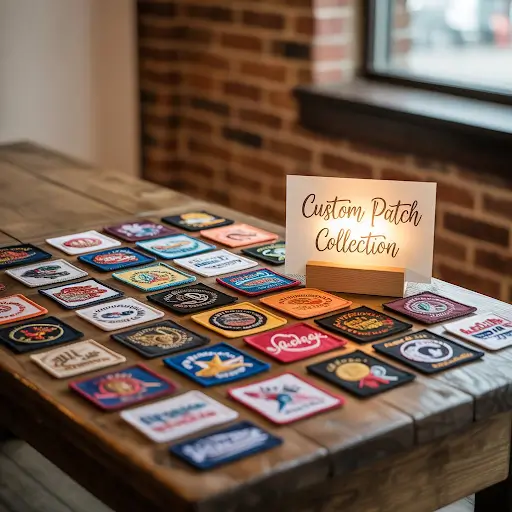Iron-on patches are a fun way to customize clothes. They can cover up small tears, add style, or bring new life to an old favorite cloth. But sometimes you change your mind or the patch doesn’t sit right. Or you think of removing it. That’s when the tricky parts start.
Removing an iron patch from fabric is not as simple as peeling it off. When the patch is placed on a fabric with iron its glue melts down into the fabric for stronger bonding and lasting finishing. But when it comes to removing the patch the glue makes it hard to take off, and some glue residue remains there with the fabric.
If you do not use the right methodology for removing your iron-on patch you may damage your clothes. This comprehensive guide offers various safe methods for removing patches.
Why Removing Iron-On Patch Glue Can Be Tricky
Patch glue melts deep into fabric fibers when heat is applied. This bond makes patches last through repeated washes and daily wear. The same strong hold is also what makes removal difficult. As well, this also happens when you design your own patch and use a general glue that goes way beyond the fabric layers.
If you use too much heat or the wrong solvent, you risk burning, fading, or tearing the fabric. By choosing the right method for your material, you can safely remove the glue without ruining your clothes.
How to Prepare Your Fabric for Glue Removal?
A few things are necessary to be checked before putting your fabric to the test. This can help in the easy removal of the patch as well as keep the fabric safe.
● Check Fabric Type
Not all fabrics are the same. Cotton and denim can handle higher heat, while silk or polyester need extra care which is why it is necessary to choose the right patch type in accordance with the fabric to avoid future hurdles. With iron on patches always check the label before applying heat or chemicals to the fabric. This small step can save your favorite shirt or jacket from damage.
● Test on a Hidden Area
For safety measures, always test a hidden part of the fabric first. Use a small amount of acetone or any other chemical or adhesive remover on it.
Then keep an eye on it for a while. If the fabric changes color or structure then gently remove the chemical and check for the safety precautions on the clothes before applying anything.
● Gather the Right Tools
Depending upon the method you use. Keep all the necessary things close before starting any procedure.
For the heat method, use an iron or hairdryer. For chemical methods, use a cotton cloth, tweezers, acetone or nail polish remover, and for the steam method, keep hot water and a butter knife.
How to Remove Patch Glue with Heat
The heat method to remove patch glue is a simple and safe procedure that can be used on almost all fabrics except silk, wool and jersey. To use this method follow the following steps:
Test a hidden spot. Cover a small inside hem with the cloth and press for 10 seconds. Look for color change or fabric thinning. If any change appears, stop and switch methods.
Cover the patch with the cloth or parchment paper to protect the fabric.
Set the iron to medium heat. Turn off the steam.
Press the iron gently onto the covered patch for 10 to 15 seconds. Do not hold the iron in one place longer than 15 seconds.
Lift the cloth and check the edge of the patch.
If the glue still feels hard, repeat steps 5–8 until the glue softens and peels away.
How to Remove Adhesive From Fabric with Acetone
When heat does not work best for you. Use acetone to remove patch glue. It helps in dissolving the remaining glue. As well it’s a strong chemical so extra care needs to be taken in order to save the fabric.
Test acetone (or nail polish remover with acetone) on a hidden corner of the fabric.
To prevent the spread of chemicals and glue. Place a paper towel below the stained area.
Dip a soft cloth or cotton ball in acetone and gently dab it on the glue.
Wait for a few minutes until the glue completely softens and scrape it away.
Rinse the fabric with cold water.
How to Use Steam Method for Safer Removal
For thick fabrics like denim, steam works very well in softening the glue. This method is good for hoodies, jackets, and hats, especially.
Heat water in a pot until it starts to boil.
Then keep the glued area above the steam for as long as it feels like softening. It takes approximately 30 to 60 seconds for the glue to loosen.
Use a tweezer to remove the patch first and then use a butter knife to scrape the glue away.
Repeat until clean.
Tip: A garment steamer or the steam setting on your iron can also work.
Easy Steps of Using Adhesive Removers
Commercial adhesive removers are designed for tough glue. They are safe on most fabrics but should still be tested first.
Read the label instructions carefully.
Apply a small amount on the glue and wait for the recommended time.
Blot with a clean cloth and lift the residue away.
Wash the garment to remove any chemical smell.
Note: Choose fabric-safe removers. Avoid industrial-strength products meant for hard surfaces.
Final Cleaning
To keep the fabric fresh and to get rid of any chemical or glue residue, give the fabric a gentle wash.
Use fabric softener and mild detergent along with cold water to clean the fabric bristles gently. Let the fabric dry completely in natural air and then reuse it.
FAQs
Can woven patches be used for different types of clothing?
Yes! Woven patches are versatile and can be used on various clothing items, including jackets, hats, uniforms, and bags. They are perfect for adding a personalized touch to any garment or accessory
What backing options are available for custom woven patches?
You can choose from several backing options like iron-on, sew-on, peel-and-stick, and Velcro. Each option offers different benefits depending on whether you need a permanent or temporary attachment.
How durable are woven patches compared to embroidered patches?
Woven patches are made from high-quality threads that are tightly woven, making them durable and long-lasting. They can withstand regular wear and washing without losing their detail or shape, making them great for uniforms and everyday apparel.
Are there minimum order requirements for custom woven patches?
At Patch Makers USA, we offer flexibility with our order sizes. Whether you need a small batch for a special event or a bulk order for branding, we can accommodate your needs.
Will acetone ruin my clothes?
Acetone can damage delicate fabrics like silk, wool, and acetate. Always test before applying it fully.
What if glue doesn’t come off with heat or acetone?
Try a fabric-safe adhesive remover. If it still doesn’t work, take the garment to a professional cleaner.
Is vinegar safe for glue removal?
Yes. Vinegar is safe for most fabrics and is a natural option.
Can I reuse a patch after removing it?
No. Once removed, the adhesive weakens. It’s better to sew it back on.
Conclusion
Removing iron-on patch glue does not need to be stressful. With heat, freezing, acetone, or simple household solutions, you can restore your clothes safely. Each method works best depending on fabric type and glue strength.
At The American Patch, we believe in giving your clothes a second life. If you love patches, try exploring our how to iron on patches guide and learn smarter ways to apply and maintain them. Our goal is to help you enjoy the style of patches without the stress of damage.
By following these safe methods and tips, you’ll not only remove stubborn glue but also protect your clothes for the future.
“Neque porro quisquam est, qui dolorem ipsum quia dolor sit amet, consectetur, adipisci velit, sed quia non numquam eius modi tempora incidunt ut labore et dolore magnam aliquam quaerat voluptatem.”
A 1914 English translation by Harris Rackham reads:
“Nor is there anyone who loves or pursues or desires to obtain pain of itself, because it is pain, but occasionally circumstances occur in which toil and pain can procure him some great pleasure.”
McClintock’s eye for detail certainly helped narrow the whereabouts of lorem ipsum’s origin, however, the “how and when” still remain something of a mystery, with competing theories and timelines.
“Neque porro quisquam est, qui dolorem ipsum quia dolor sit amet, consectetur, adipisci velit, sed quia non numquam eius modi tempora incidunt ut labore et dolore magnam aliquam quaerat voluptatem.”
A 1914 English translation by Harris Rackham reads:
“Nor is there anyone who loves or pursues or desires to obtain pain of itself, because it is pain, but occasionally circumstances occur in which toil and pain can procure him some great pleasure.”
McClintock’s eye for detail certainly helped narrow the whereabouts of lorem ipsum’s origin, however, the “how and when” still remain something of a mystery, with competing theories and timelines.
“Nor is there anyone who loves or pursues or desires to obtain pain of itself, because it is pain, but occasionally circumstances occur in which toil and pain can procure him some great pleasure.”







